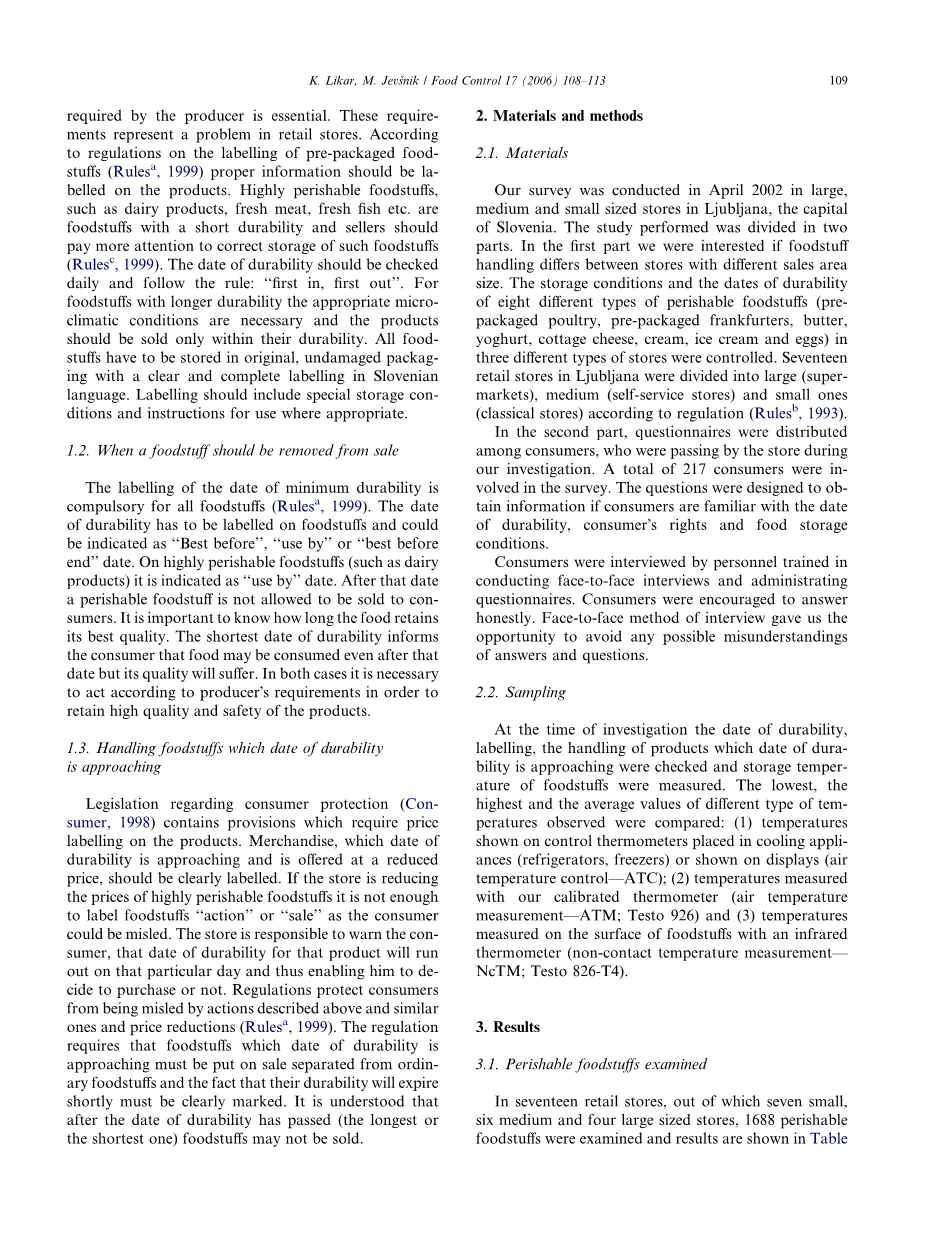

英语原文共 6 页,剩余内容已隐藏,支付完成后下载完整资料
附录B 外文原文
Cold chain maintaining in food trade
Abstract
The concept of food safety has lately acquired a new approach due to globalization and free trade in food. Introducing a HACCP system in the production and trade in food has become a necessity. The term lsquo;lsquo;food tradersquo;rsquo; indicates all the postproduction procedures, from storage, transport and distribution to retail, including export and import. The aim of our 2002 survey was to analyse the situation of cold chain maintaining in food trade in Ljubljana, the capital of Slovenia. The research was based upon two hypotheses: in the first one we supposed that a cold chain is interrupted in retail and in the second one we supposed that the handling of food in retail varies. Seventeen stores were divided in three groups, according to sales area of the store: large ones, medium ones and small ones. Temperature conditions in cooling appliances for storage of 1688 perishable food products were measured. Products were inspected by two criteria, by the lsquo;lsquo;best beforersquo;rsquo; date and by the storage temperature. The results confirmed both of the hypotheses. The storage conditions were properly labelled on the packages of the products inspected. In most of the cases the temperatures measured differed from the required ones, even for up to 10 LC. The biggest differences were detected between temperatures indicated on cooling appliances and temperatures measured by our calibrated thermometers. Conditions during food storage and in retail stores were not documented and there was no system to control the cold chain. Our findings have shown that retailers are not familiar with the importance of maintaining a cold chain. The result of that can be a shorter durability of highly perishable foodstuffs and their safety for consumers is questionable.
2004 Elsevier Ltd. All rights reserved.
Keywords: Cold chain; Food trade; Retail; Storage
1. HACCP in food trade
Lately food safety has acquired a great importance due to the globalization and free trade in food. In the past food retail has always adapted to new social cir-cumstances in a short time and is one of the oldest and vital human activities. Introducing HACCP systems to the production and the food trade enables food trace-ability and ensures safe food according to sanitary requirements. The term lsquo;lsquo;food tradersquo;rsquo; indicates all the postproduction procedures: storage, transport, distribu-tion and retail of final products, their export and import. The cold chain maintaining in retail represents the biggest problem to producers and retailers. According to legislation (Rulesb, 1993), stores are classified with re-gard to sales areas: classic stores (above 12m2), self-service stores (above 40m2) and supermarkets (above 1000m2). In Slovenia food safety and safety of products that may come into contact with food is regulated by the law (Act 2000, 2002). In Slovenia a HACCP system is compulsory since January the 1st 2003. It is a responsi-bility of salesmen to ensure food traceability and food safety by internal control in all trade phases. The pur-pose of our survey in April 2002 was to analyse the cur-rent situation in maintaining a cold chain in food trade.
1.1. Cold chain and food durability
For highly perishable foodstuffs a cold chain below 5 LC or at temperature that is indicated on a label and required by the producer is essential. These require-ments represent a problem in retail stores. According to regulations on the labelling of pre-packaged food-stuffs (Rulesa, 1999) proper information should be la-belled on the products. Highly perishable foodstuffs, such as dairy products, fresh meat, fresh fish etc. are foodstuffs with a short durability and sellers should pay more attention to correct storage of such foodstuffs (Rulesc, 1999). The date of durability should be checked daily and follow the rule: lsquo;lsquo;first in, first outrsquo;rsquo;. For foodstuffs with longer durability the appropriate micro-climatic conditions are necessary and the products should be sold only within their durability. All food-stuffs have to be stored in original, undamaged packag-ing with a clear and complete labelling in Slovenian language. Labelling should include special storage con-ditions and instructions for use where appropriate.
1.2. When a foodstuff should be removed from sale
The labelling of the date of minimum durability is compulsory for all foodstuffs (Rulesa, 1999). The date of durability has to be labelled on foodstuffs and could be indicated as lsquo;lsquo;Best beforersquo;rsquo;, lsquo;lsquo;use byrsquo;rsquo; or lsquo;lsquo;best before endrsquo;rsquo; date. On highly perishable foodstuffs (such as dairy products) it is indicated as lsquo;lsquo;use byrsquo;rsquo; date. After that date a perishable foodstuff is not allowed to be sold to con-sumers. It is important to know how long the food retains its best quality. The shortest date of durability informs the consumer that food may be consumed even after that date but its quality will suffer. In both cases it is necessary to act according to producer s requirements in order to retain high quality and safety of the products.
1.3. Handling foodstuffs which date of durability is approaching
Legislation regarding consumer protection (Con-sumer, 1998) contains provisions which require price labelling on the products. Merchandise, which date of durability is approaching and is offered at a reduced price, should be clearly labelled. If the store is reducing the prices of highly perishable foodstuffs it is not enough to label foodstuffs lsquo;lsquo;actionrsquo;rsquo; or lsquo;lsquo;salersquo;rsquo; as the consumer could be misled. The store is responsible to warn the con-sumer, that date of durability for th
剩余内容已隐藏,支付完成后下载完整资料
资料编号:[486523],资料为PDF文档或Word文档,PDF文档可免费转换为Word


